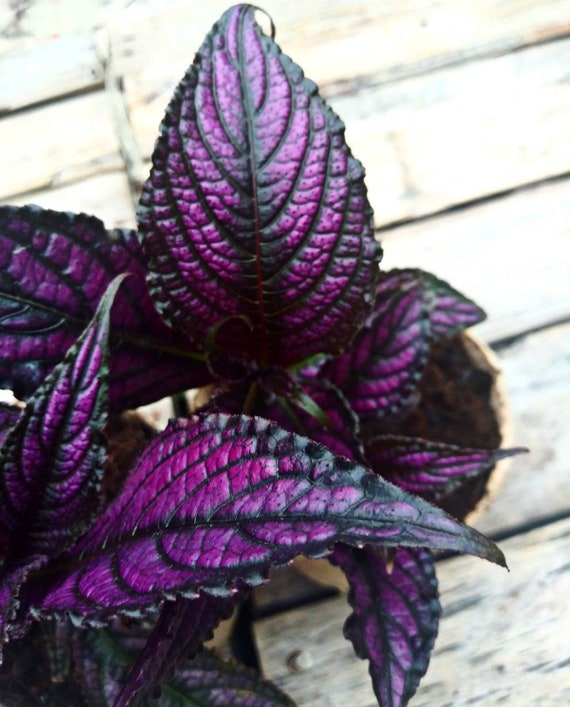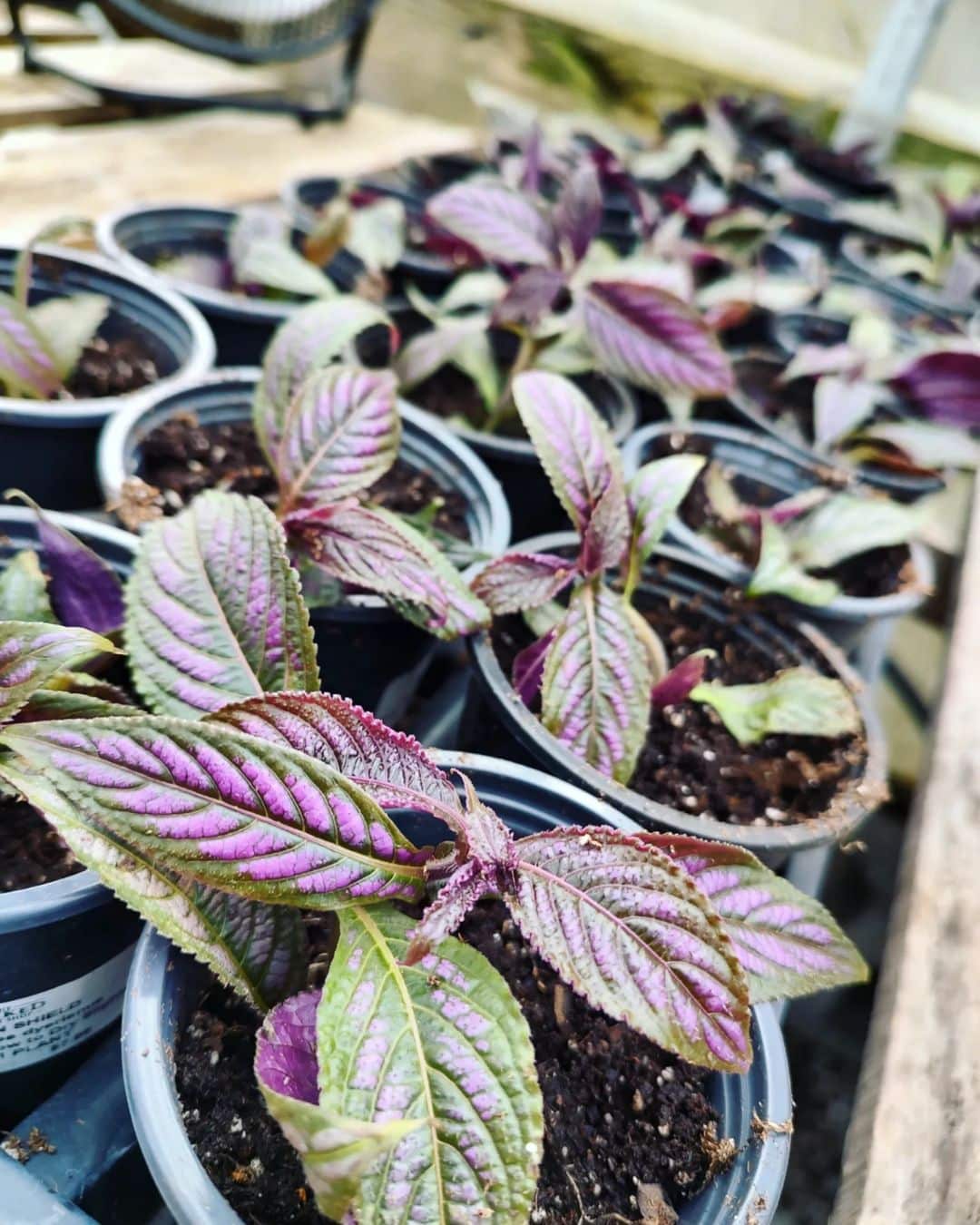If you’re a plant enthusiast looking to expand your collection or simply want to share the beauty of the Persian Shield plant (Strobilanthes dyerianus) with others, learning how to propagate this stunning foliage plant is a must. With its iridescent purple leaves and silver accents, the Persian Shield adds a touch of exotic elegance to any garden or indoor space. In this article, we will guide you through the process of propagating Persian Shield plants successfully.
Understanding Persian Shield Plant Propagation
Before diving into the propagation process, it’s important to understand how Persian Shield plants reproduce naturally. These plants are typically grown from stem cuttings rather than seeds. Stem cuttings involve taking a section of a healthy stem and encouraging it to root and grow into a new plant.
Selecting the Right Cutting
To start propagating your Persian Shield plant, you’ll need to select a healthy and mature stem for cutting. The ideal stem should be around 4-6 inches in length and have at least two sets of leaves present. Look for stems that are firm and free from any signs of disease or damage.
Preparing the Cutting
Once you’ve identified a suitable stem, it’s time to prepare it for propagation. Using clean and sharp pruning shears, make a clean cut just below a node (the point where leaves emerge). Nodes contain important hormones that promote root growth, making them essential for successful propagation.
After making the initial cut, remove any leaves from the lower third of the stem. This will prevent excessive moisture loss during the rooting process and encourage energy allocation towards root development.
Rooting Hormone Application
Although not necessary, applying a rooting hormone can significantly increase the success rate of your Persian Shield plant propagation. Rooting hormones contain growth-promoting substances that help stimulate root formation in cuttings.
To apply rooting hormone, dip the lower end of the cutting into the powder or liquid form of the hormone. Ensure that the hormone covers the freshly cut surface and shake off any excess. Remember to follow the manufacturer’s instructions for dosage and application.
Propagation Medium and Container
After preparing the cutting, it’s time to choose an appropriate propagation medium and container. Persian Shield plants prefer well-draining soil to prevent waterlogged roots. A mix of perlite, vermiculite, and peat moss or a commercial rooting mix will provide the ideal conditions for root development.
Select a clean container with drainage holes to prevent water accumulation. Fill the container with your chosen propagation medium, leaving enough space at the top for planting the cutting.
Planting and Caring for the Cutting
Gently insert the prepared cutting into the propagation medium, ensuring that at least one node is buried beneath the soil. Firmly press down around the cutting to provide stability. Water the cutting thoroughly but avoid overwatering, as excessive moisture can lead to rotting.
To create a greenhouse-like environment that promotes humidity, cover the container with a clear plastic bag or use a propagation tray with a transparent lid. Place the container in a warm location with bright, indirect light.
Throughout the rooting process, monitor moisture levels by lightly misting the cutting and checking the soil regularly. Maintain a consistently moist but not soggy environment to encourage root growth.
Rooting and Transplanting
Rooting times may vary depending on environmental conditions and plant health, but Persian Shield cuttings typically take around 4-6 weeks to develop roots. To check for root development, gently tug on the cutting after a few weeks. If you feel resistance, it’s a good sign that roots have formed.
Once roots have sufficiently developed, it’s time to transplant your Persian Shield plant into a more permanent container or garden bed. Choose a location with partial shade and well-draining soil to ensure optimal growth.
Caring for Propagated Persian Shield Plants
After transplanting, caring for your newly propagated Persian Shield plants is essential to their continued health and beauty. Here are a few key care tips:
Watering
Persian Shield plants prefer consistently moist soil but can suffer from root rot if overwatered. Water when the top inch of soil feels dry, and always allow excess water to drain away.
Light
These plants thrive in bright, indirect light. Avoid placing them in direct sunlight, as it can scorch the delicate leaves.
Temperature and Humidity
Persian Shield plants prefer warm temperatures between 60-80°F (15-27°C) and high humidity levels. Consider using a humidifier or placing a tray filled with water near the plant to increase humidity.
Fertilization
Feed your Persian Shield plant with a balanced liquid fertilizer during the growing season, following the manufacturer’s instructions for dosage and frequency.
By following these propagation and care guidelines, you can successfully propagate Persian Shield plants and enjoy their stunning foliage for years to come. Remember, patience is key during the rooting process, so don’t be discouraged if it takes some time for your cuttings to establish roots. With a little care and attention, you’ll soon have a flourishing collection of these striking purple beauties.
Ideal Conditions for Growth
Persian Shield plants thrive in specific conditions that enhance their vibrant foliage and overall health. Creating the right environment boosts growth and makes propagation a rewarding experience.
Light Requirements
Persian shields love bright, indirect sunlight. A spot near a window works well, but avoid direct sun exposure, which can scorch their leaves. If you notice faded colors, that’s a sign they crave more light. Yet, too much sun can dampen their vibrant hues. It’s a delicate dance, but with the right balance, these beauties flourish.
Common Challenges in Propagation

Propagation can be a fun journey, but it brings its own set of challenges. Understanding these hurdles helps turn potential setbacks into learning moments.
Pests and Diseases
Pests can sneak into my Persian shield collection when I least expect it. Aphids and spider mites love to target these vibrant plants. To spot them, I check for discoloration or tiny webs on the leaves. If I see signs, I act quickly with insecticidal soap or neem oil. Keeping my plants healthy also reduces the risk of disease. Root rot can occur if I overwater, so I make sure my soil drains well. Checking moisture levels is a good habit that pays off.
Environmental Stressors
Environmental factors can also throw a wrench in my propagation plans. Persian shields thrive in bright, indirect light, but too much direct sun can lead to crispy leaves. It’s important to find that sweet spot. Humidity plays a big role too. I can create a humid environment by misting the plants regularly or using a pebble tray filled with water. Cold drafts can shock these plants, so I keep them away from windows during winter. Attention to these details helps my propagation efforts flourish.
Frequently Asked Questions
What is a Persian shield plant?
The Persian shield (Strobilanthes dyerianus) is a tropical plant known for its striking purple leaves that resemble watercolor artwork. It’s popular for both indoor gardens and outdoor landscapes due to its vibrant colors and distinctive foliage.
How do you propagate Persian shield plants?
Persian shield plants can be propagated through stem cuttings or division. For stem cuttings, take a healthy 4 to 6-inch stem section, cut just below a node, and place it in water or soil. Division involves separating sections of the root system from an established plant and re-potting them.
What are the ideal growing conditions for Persian shield plants?
These plants thrive in bright, indirect sunlight and prefer humid conditions. It’s best to place them near a window while avoiding direct sunlight, which can scorch their leaves.
How can I maintain humidity for my Persian shield plants?
To maintain humidity, consider misting the leaves regularly or using a pebble tray filled with water. This will help keep the environment suitable for the plant’s growth and vibrancy.
What pests and diseases affect Persian shield plants?
Common pests include aphids and spider mites. To handle infestations, use insecticidal soap or neem oil. Additionally, avoid overwatering to prevent root rot and monitor for other environmental stressors.
Do Persian shield plants improve indoor air quality?
Yes, Persian shield plants help filter toxins from the air, enhancing indoor air quality while adding aesthetic appeal to your living space. Their vibrant colors contribute to a lively atmosphere in any room.
Can Persian shield plants be grown outdoors?
Absolutely! Persian shield plants can be grown outdoors in suitable climates. They prefer warm, humid environments and should be protected from direct sunlight to maintain their vibrant colors.
How do I know if my Persian shield needs more light?
If the leaves of your Persian shield are fading or losing their vibrancy, it may need more light. However, be cautious, as too much direct sunlight can scorch the leaves.
Final Thoughts
Propagating Persian Shield plants has been a truly rewarding journey for me. Their stunning appearance and air-purifying qualities make them a fantastic addition to any space. By utilizing simple techniques like stem cuttings and division, I’ve been able to expand my collection effortlessly.
Creating the right environment is key to thriving Persian shields. With proper lighting and humidity, these plants flourish beautifully, enhancing the overall ambiance of my home. Staying vigilant about pests and environmental stressors has been crucial, ensuring my plants remain healthy and vibrant.
I encourage you to dive into the world of Persian Shield propagation and experience the joy it brings to your gardening endeavors.
Don’t forget to add theherbprof.com homepage to your favourites so you don’t miss out on future articles.
Meta Title: How to Propagate Persian Shield – Step-by-Step Guide
Meta Description: Learn how to propagate Persian Shield plants with our easy-to-follow guide. Perfect for beginners and plant enthusiasts.
Author: Jane Doe
Title/Role: Horticulture Expert
Credentials: With over 10 years of experience in plant propagation and care, Jane has helped thousands of gardeners grow beautiful plants.
Profile Link: https://www.theherbprof.com/jane-doe
Sources:
– Little Herb Encyclopedia
– Planetary Herbology
– Handbook of Medicinal Herbs
Internal Links:
– How to Grow Clove Pink
– Best Companion Plants for Cabbage
– Kiwi Fruit Health Benefits
Schema Markup:
{
"@context": "https://schema.org",
"@type": "Article",
"headline": "How to Propagate Persian Shield: A Step-by-Step Guide for Beginners",
"datePublished": "2023-10-05",
"dateModified": "2023-10-05",
"author": {
"@type": "Person",
"name": "Jane Doe"
},
"publisher": {
"@type": "Organization",
"name": "The Herb Prof",
"logo": {
"@type": "ImageObject",
"url": "https://www.theherbprof.com/images/logo.png"
}
},
"description": "Learn how to propagate Persian Shield plants with our easy-to-follow guide. Perfect for beginners and plant enthusiasts."
}
Featured Snippet Optimization:
“Learn how to propagate Persian Shield plants with this step-by-step guide. Start with healthy cuttings, use rooting hormone, and provide the right conditions for successful growth.”
Call to Action:
Stay updated with the latest news and tips on plant propagation and care. Explore our website for more guides and resources.
URL Slug:
how-to-propagate-persian-shield
Image Optimization:
 alt text: “Persian Shield plant propagation process”
alt text: “Persian Shield plant propagation process”
alt text: “Healthy Persian Shield plant stem cutting”
 alt text: “Prepared Persian Shield cutting with removed lower leaves”
alt text: “Prepared Persian Shield cutting with removed lower leaves”
 alt text: “Propagation container filled with well-draining soil mix”
alt text: “Propagation container filled with well-draining soil mix”
alt text: “Covered container with Persian Shield cutting in propagation medium”











More Stories
US Trending News: The History and Legacy of Zoo York in Streetwear Culture
What Is Yodo Para Tiroides and How Does It Affect Thyroid Health?
Understanding ‘You Got That Right’ in The New York Times: Context and Implications